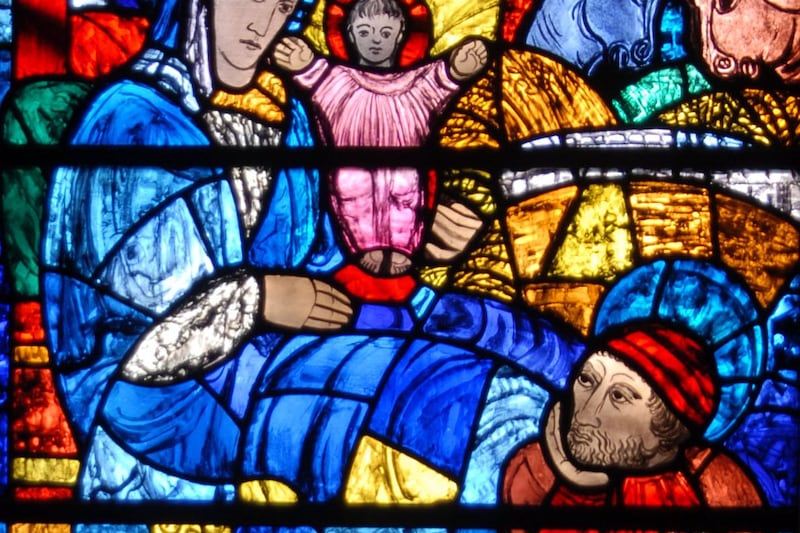It is an unseasonably cold July morning, in a secluded location in the Comeragh mountains, Co Waterford. Sheltering from the chill wind behind a rocky outcrop above a lake, I am hoping for rescue, while also aware that nobody knows my exact location. Having helped out a few times with sweep searches of the mountains for missing hillwalkers, I am well acquainted with the difficulty of finding someone lost amid rough, unforgiving upland terrain. A rescuer could walk within five metres of where I am now lying and not be aware of my presence, so it could be a long, cold wait.
Then, the distant sound of a bell moves steadily closer. On the ridge above, a border collie wearing an orange search-and-rescue jacket suddenly appears and gazes at me with what appears to be bemusement. As quickly as she appears, she is gone, but soon after I hear excited barking as she communicates to her handler that she has found a missing person.
A short time later Ali Tobin, from Sarda Ireland (Search and Rescue Dogs Association of Ireland) appears above me; clearly, I am now in safe hands. As we walk back to join the other Sarda members, Ali introduces me to her search dog, Daisy. There is a very strong bond based on mutual trust between the two, with Daisy eager to please her handler. Ali proudly tells me she is, at 19 years of age, the youngest dog handler to have gone through the arduous process of fully qualifying a search-and-rescue dog.
I was not actually lost but playing the role known to search teams as a “dogsbody”. This is someone who finds a secluded hiding place on a mountainside so rescue dogs can search them out as part of an exercise. It is an important role without which the dogs cannot be trained as efficient and effective rescuers.
READ MORE
The idea of using dogs for mountain rescue comes originally from Switzerland. Heart-warming stories of Great St Bernards saving travellers on the snowy wildernesses of the high Alps have long been a godsend for newspaper editors and film producers. Like many legends, these stories have a basis in fact. A traverse of the St Bernard Pass linking Switzerland with Italy, which is covered in snow much of the year, was once a dangerous but necessary journey for many who crossed the Alps. The area claimed many victims. Given this, Augustinian monks founded a hospice at the 2,500m highest point as a shelter for cold and weary travellers.
The monks soon discovered that the local St Bernard dogs had a strong sense of smell. Finding people buried in snow was their forte, and they were also excellent at navigating through a blizzard. The Augustinians began sending them out in snowstorms to seek lost or injured travellers.
Inevitably, legends grew up around the cute, photogenic St Bernards; one alleged the dogs always had casks of brandy attached to their collars to revive the frozen victims. Disappointingly, the brandy casks have no basis in fact, but what became obvious was that these powerfully built dogs were far superior and much quicker than humans when it came to finding lost travellers. One renowned St Bernard, Barry, is reputed to have saved more than 40 lives during his lifetime.
These dogs had no formal training and relied on instinct to rescue people, but what of the modern rescue dog? In what way are they different? To find out I join Sarda Ireland for one of their training exercises in the Lough Mohra area of the Comeragh Mountains.
On my arrival, the immediate surprise is that there are no St Bernards in evidence, so I question the former training officer with Sarda Ireland, Gerry Tobin, about the absence of these lovable, Alpine dogs.
“The St Bernard is actually a good search-and-rescue dog, particularly in deep snow, where their strength is a big advantage. In Ireland, we don’t get so much deep snow and these dogs have the disadvantage of being heavy and bulky in a helicopter. For this reason, we opt mainly for smaller breeds. These are equally good at finding missing persons but are more agile and easier to helicopter into a search area.”
While we wait for the training exercise to begin, Gerry tells me about the history of Sarda. “It arose in 1965 when Scottish mountaineer Hamish MacInnes visited a training course in Switzerland for rescue dogs used to find people buried by avalanches. He wondered if such dogs could also be trained to find people lost on open mountain and among heather and woodland on these islands.
MacInnes found they could, and Sarda came into existence in Scotland, proving its worth in locating bodies scattered over a wide area after the Lockerbie air disaster. Following the success of the Scottish search dogs, Sarda Ireland was formed in 1987. It is a volunteer-based charity that has since been training and deploying search dog teams to find people missing in Ireland.
So, what breed makes a good search-and-rescue dog? “The dog’s temperament and physique are more important than its breed. Big dogs are often too heavy and slow for quick searching. Small dogs don’t have the speed and stamina to cover long distances. Our dogs are drawn from the midsize working breeds. In the team, we have a mixture of German shepherds, border collies, springers, retrievers and one Labrador.
“Since a dog’s sense of smell is much more sensitive than ours, they can air scent to search, since humans continually shed skin particles into the atmosphere. A person that cannot otherwise be seen can be located by a dog following its nose, often in areas inaccessible to human rescuers. They are extremely effective in the very situations where humans are most limited: in the dark, in woodlands, in thick brush, in poor visibility. We also have two trail dogs in training to operate on a lead. They are learning to follow just one human scent and ignore any other people in the area. They will be very useful when we know the location a missing person set out from. In all other cases, the air-scent dogs are superior.”
To see how all this works, we head out on to open mountainside and the training exercise begins. A volunteer dogsbody has already been placed at a hidden location in the area to be searched. Border collie Rosie and her handler Helen Connolly then begin by moving to high ground downwind of the search area. Soon after Rosie is away and scampering rapidly right and left across the wind as she tries to pick up a human scent. After a few minutes, Gerry Tobin suddenly exclaims, “She has it.” He then tells me that Rosie has found the scent because her head is now up and she is moving in one direction.
The search isn’t straightforward, however; the scent leads to the base of a small, rocky cliff. At this stage, Tobin points out that an intelligent dog is now required, “who will abandon the scent and try to find her way around the cliff. Having done this, she must then move back to the area where the scent is most likely to be”.
Rosie is an old hand and soon figures out how to make her way around the cliff and then moves upwards to rediscover the scent. Next she darts assuredly among rocky outcrops as she homes in on the person. An excited bark announces the find, and then Rosie scampers back to Helen and leads her to the dogsbody.
Afterward, I chat with Connolly about her dog. She tells me Rosie has been on missing-person searches in the Comeraghs and Galtee mountains, MacGillycuddy’s Reeks and the Mount Brandon range. I ask her what motivates the dog to keep trying to find somebody in such tough and demanding terrain. “The motivation for Rosie is that she is given praise and her favourite toy to play with after she finds a missing person. This acts as her incentive to keep searching, so we initially look for dogs with a strong play drive that are eager to please their handler.”
But how do they search for a missing person in terrain that is new to both dog and handler? “We are given an area to search by the authorities and we then establish what is known as a scent-collecting boundary on the downwind side of the area. The dog moves along this boundary trying to find a scent. If we find nothing, Rosie moves deeper into the area and tries to search the most likely locations where the missing person might be. We keep criss-crossing until we make a find, or declare the area clear. Declaring an area clear is a big help to the search-and-rescue teams because this allows them to narrow the area where the missing person is likely to be.”
Later, I speak to dog-handling volunteer Winnie Flynn and ask her how she became involved. “I always loved dogs and grew up with them all around. When I was a member of South East Mountain Rescue Team, I saw a demonstration of search dogs in action and immediately knew I wanted to do that. It took me two years to find a suitable dog for training that was good with people and other dogs. In 2019 I acquired a golden retriever/collie cross called Flame from a family in Cork.”
And how did she train Flame as a rescue dog? “It took about two years. First you must get the dog to love playing with a toy and to bark whenever she wants the toy, which can be a bit trying for others in the house. Next you play hide-and-seek with the dog and give them the toy with lots of praise when they find you, so it’s all about search and reward. Before a dog is allowed on to the mountains for formal training, it must pass an obedience and stock test, which means they are trained to obey the handler and ignore livestock. The final assessment is a tough test over three days aimed at showing that the dog can meet all the challenges of search-and-rescue in different terrain and conditions, and also how the dog and handler can work as a team. I was over the moon when Flame passed with flying colours.”
Next I am introduced to a man holding tightly to a cute, nine-week-old, German shepherd puppy, who has travelled from Dublin to join the Sarda session. A former athlete and fell runner, Richie Donelan, tells me he has had a strong affection for animals since childhood and spent much of his early years working with horses. He enjoyed fell-running but came to believe that the speed he travelled at left little time to enjoy the uplands. “You spent most of the time looking down at your feet and see very little otherwise.”
Deciding he wanted to own a working dog, he joined Sarda Ireland to find out more about the responsibilities involved and also to give something back in return for the good times he had had among the hills. He has spent the past 18 months volunteering as a dogsbody during training sessions, which gave him plenty of time to appreciate what is required of a rescue dog handler.
He is overjoyed to have acquired a puppy named Raidr, donated by Brendan and Kate Lawlor of Kalee Lodge Kennels in Co Offaly, for training as an air-scenting search dog. He believes this will give Raidr the best possible life, as he will have something to do, which is what working breeds most enjoy. “Air-scenting dogs work off the lead and often out of sight. They are free to roam as they please, meaning there must be a sense of mutual trust between handler and dog. That is the kind of equal relationship I want to build with Raidr,” says Donelan.
Finally, I return to Gerry Tobin and ask him about his most personally rewarding find of a missing person during his 25 years as a rescue dog handler. “It was some years ago when I was called out late one night with search dog Dex to a wood where a woman had failed to return from a walk. A search had been ongoing for many hours, involving civil defence, three mountain rescue teams and a helicopter, without result. I arrived soon after midnight and immediately headed into the wood. Dex started following a boardwalk through the darkness and I felt he was on to something. Suddenly he broke left and disappeared through thick brush. After a time Dex came back barking, so I knew he had found something. He then led me through the brush, across a very wet bog and finally up on a bank. Below, a woman was lying unconscious, hypothermic and barely breathing. We kept her warm until medical help arrived and she was transported to hospital. She eventually made a full recovery, but doctors afterward assured me that had Dex not found the missing person almost immediately, she would most likely have passed away during the night.”
Further information on Sarda Ireland and details on how to donate at sardaireland.com















